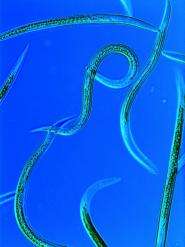UA pursues links between worms and their bacteria

The NemaSym Research Coordination Network is an opportunity for scientists to collaborate on nematode research.
Nematodes, commonly called roundworms, inhabit every ecosystem on Earth. About 30,000 species have been described so far; scientists also suspect that as many as 1 million species exist.
Many of these roundworms are linked with bacteria in a wide variety of relationships that can benefit or harm plants, animals and humans.
The Nematode-Bacterium Symbioses Research Coordination Network, headquartered at the University of Arizona, focuses on microbe and roundworm interactions as model systems for understanding biological processes, primarily in medicine and agriculture.
Created in 2009 and funded by the National Science Foundation, NemaSym's goal is to promote worldwide interaction and discourse among scientists who work in the field of nematode-bacteria symbiosis.
"Scientists conduct research with various types of roundworms such as those that parasitize humans, plants, animals – but their efforts are often separate and specialized," said Patricia Stock, professor of entomology in the UA College of Agriculture and Life Sciences and lead principal investigator for NemaSym.
"With this network, they have become aware of many common aspects of each other's research and have learned they can share techniques and other tools that can be applied to their specific systems. NemaSym has been really successful, with about 50 scientists involved so far, from about 25 countries in nearly every continent."
Institutions cooperating in the NSF-RCN include the UA, North Carolina State University, University of Wisconsin-Madison and the University of Pittsburgh.
The study of nematode-bacteria interactions is only part of a larger worldwide effort to understand how all microbes – bacteria, viruses, protozoa, fungi and algae – interact with other organisms in various ecological niches. Symbioses between bacteria and nematodes go back millions of years, according to Stock.
"Plant and animal symbioses with microbes are incredibly diverse and play key roles for the existence of life on this planet," Stock said. "From the most primitive organisms to the most evolved, all have interactions with microbes."
For example, certain roundworms travel with bacteria in their intestines that specifically kill insects. These nematodes may enter a host either through natural openings – mouth, anus or spiracles – or penetrate the host directly using a dorsal tooth. Once inside the host, the worm releases the bacteria, which kill the insect and allow their worm partners to grow and multiply.
"This nematode-bacterium partnership is currently used as a biological control alternative for insect pest management," Stock notes.
Plant diseases like certain stone-fruit cankers are caused by bacteria vectored by nematodes.
"The nematodes feed on the roots of the trees, and while sucking fluids, they inject bacteria into the plant. This is a typical commensalistic interaction where the nematodes assist the bacteria in reaching a plant host, but they do not get harmed by vectoring the bacteria," Stock said.
A different approach is needed in some medical cases.
"Filarid worms cause severe diseases in Africa and other regions, such as river blindness or elephantiasis," said Stock. "Patients in the past were treated with drugs that had severe effects, targeting the worms. Now, after the discovery that it's the symbiotic bacteria within those worms that control their reproduction, antibiotics have become the tool to control the bacteria that control the worms."
NemaSym is currently the only group in the world dedicated to studying the broad scope of nematode-bacteria interactions and the only NSF-funded research coordination network with a lead principal investigator at the UA.
"NemaSym fills a critical need in crossing interdisciplinary lines among scientists and getting them to interact," Stock said. The network encourages scientists engaged in basic and applied research to explore how cross-talk and networking can enhance and advance science in this field.
The group also develops and distributes educational materials to students and educators. NemaSym's website has links to material for teachers to use in their classrooms. "We provide a lot of outreach," she said.
The network meets in person annually, often as a satellite to other groups. The fourth annual meeting, "Origins and Evolution of Nematode-Bacteria Associations," will be held April 3-6 at the Cold Spring Harbor Laboratory, New York, as a satellite to a conference on "Evolution of Caenorhabditis and Other Nematodes."
Scientists, their postdoctoral associates and graduate students usually attend, and travel training awards are given annually to qualified students or early career scientists for short exchange visits to laboratories. The conferences are open to anyone who works in the field of nematode-bacteria symbiosis.
Provided by University of Arizona
















